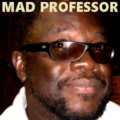 WWW,
2006 (Archived)A mason, Benjamin Franklin's
links to occult secret societies have long
been known. In a videoclip included in
this article, the History Channel talks
about his involvement in the Hellfire Club,
a secret society that conducted black masses
and orgies. WWW,
2006 (Archived)A mason, Benjamin Franklin's
links to occult secret societies have long
been known. In a videoclip included in
this article, the History Channel talks
about his involvement in the Hellfire Club,
a secret society that conducted black masses
and orgies.
These bizarre, occult practices are still
going on today in secret societies like the Bohemian
club (Alex Jones infilitrated the Bohemian
Grove and caught one of their rituals on
tape -- click here to go see the video).
 In
1998, workmen restoring Franklin's London
home dug up the remains of six children and
four adults hidden below the home. The
London Times reported on February 11, 1998: In
1998, workmen restoring Franklin's London
home dug up the remains of six children and
four adults hidden below the home. The
London Times reported on February 11, 1998:
"Initial
estimates are that the bones are about 200
years old and were buried at the time
Franklin was living in the house, which was
his home from 1757 to 1762, and from 1764 to
1775. Most of the bones show signs of having
been dissected, sawn or cut. One skull has
been drilled with several holes. Paul
Knapman, the Westminster Coroner, said
yesterday: "I cannot totally discount
the possibility of a crime. There is still a
possibility that I may have to hold an
inquest." (Scroll down to read the
entire article)
The elite's fascination with the occult is
hidden in plain view everywhere you look.
Movies like National
Treasure openly remind us of
this fascination, while prominent members of
society, like Pat Robertson, use public
venues and publications to signal their
illuminati allegiance. (In the photo to the
right, Robertson uses the masonic
Lion's Paw sign)
CLICK
HERE TO DOWNLOAD THE HISTORY CHANNEL VIDEO
CLIP
Remains of ten bodies at Ben Franklin's
home
THE SUNDAY TIMES, FEBRUARY 11, 1998
WORKMEN have dug
up the remains of ten bodies hidden beneath
the former London home of Benjamin Franklin,
the founding father of American
independence.
The remains of
four adults and six children were discovered
during the £1.9 million restoration of
Franklin's home at 36 Craven Street, close
to Trafalgar Square. Researchers believe
that there could be more bodies buried
beneath the basement kitchens.
Initial
estimates are that the bones are about 200
years old and were buried at the time
Franklin was living in the house, which was
his home from 1757 to 1762, and from 1764 to
1775. Most of the bones show signs of having
been dissected, sawn or cut. One skull has
been drilled with several holes. Paul
Knapman, the Westminster Coroner, said
yesterday: "I cannot totally discount
the possibility of a crime. There is still a
possibility that I may have to hold an
inquest."
The principal
suspect in the mystery is William Hewson,
like Franklin a Fellow of the Royal Society,
and the husband of Polly Stevenson, the
daughter of Franklin's landlady, Mary
Stevenson.
In the early
1770s Dr Hewson was in partnership with
William Hunter, who, with his brother John,
was one of the founders of British surgery.
Dr Hunter and Dr Hewson ran a school of
anatomy in Soho, but after an argument Dr
Hewson left to live in Franklin's house,
where he is believed to have established a
rival school and lecture theatre. Dr Knapman
added yesterday: "It is most likely
that these are anatomical specimens that Dr
Hewson disposed of in his own house, but we
are still not certain about the bones' exact
age or origin."
Evangeline
Hunter-Jones, deputy chairman of the Friends
of Benjamin Franklin House, the charity
concerned with restoring the property and
opening it to the public, said: "The
bones were quite deeply buried, probably to
hide them because grave robbing was illegal.
There could be more buried, and there
probably are."
Brian Owen Smith
has volunteered to lead researches on behalf
of the friends. He said yesterday: "The
discovery represents an important insight
into very exciting years of medical history.
Benjamin Franklin, through his support for
Polly and Dr Hewson, socially and
scientifically, was very much part of
that."
To the
suggestion that Franklin might have been a
grave robber, or an accomplice to Dr Hewson,
Hilaire Dubourcq, of the Friends of Benjamin
Franklin House, responded: "It is
possible that he has an alibi. It seems
likely that he actually let Dr Hewson have
use of the whole house for his school for a
time, and went up the street to live with
Mary Stevenson. He did not necessarily know
what was happening below stairs in the house
during his absence."
Dr Hewson fell
victim to his own researches at an early
age. He accidentally cut himself while
dissecting a putrid body, contracted
septicemia and died in 1774, aged 34.
Franklin, who
wrote the opening words to the Declaration
of Independence, continued to support the
widowed Polly, and when he returned to
Philadelphia he invited her there to live as
his neighbour. Both her sons became eminent
medical men, as have successive generations
of Hewsons in America.
If the first Dr
Hewson did obtain bodies for his experiments
and demonstrations by robbing local
graveyards, he risked the death penalty or
deportation. He might have had the help of
his students in secretly burying the remains
beneath the four-storey house, where the
dissections may have been performed.
It is hoped to
reopen the house to the public at the end of
the year. Regular visitors during Franklin's
residency included Pitt the Elder (the Earl
of Chatham), Edmund Burke, James Boswell,
Adam Smith and Thomas Paine, the author of
The Rights of Man.
|

































 WWW,
2006 (Archived)A mason, Benjamin Franklin's
links to occult secret societies have long
been known. In a videoclip included in
this article, the History Channel talks
about his involvement in the Hellfire Club,
a secret society that conducted black masses
and orgies.
WWW,
2006 (Archived)A mason, Benjamin Franklin's
links to occult secret societies have long
been known. In a videoclip included in
this article, the History Channel talks
about his involvement in the Hellfire Club,
a secret society that conducted black masses
and orgies.
 In
1998, workmen restoring Franklin's London
home dug up the remains of six children and
four adults hidden below the home. The
London Times reported on February 11, 1998:
In
1998, workmen restoring Franklin's London
home dug up the remains of six children and
four adults hidden below the home. The
London Times reported on February 11, 1998: